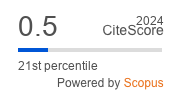An optimized approach to the surgical correction and prevention of genital prolapse in women
摘要
Urgency of the problem is due to the prevalence of genital prolapse, early onset, high rates of relapse. In this regard, this study before the goal was set: to increase the effectiveness of surgical treatment of patients with prolapse of the internal reproductive organs by developing and implementing a new method of surgical treatment and prevention of recurrent prolapse. We examined 74 women with prolapse of the internal reproductive organs in combination with other gynecological pathology: I group consisted of 38 patients who underwent surgical treatment of descent and prolapse of internal genitals by a modifi ed procedure based on the method of fixing the sacro-uterine ligaments ≪reinforced≫ aponeurotic flap; Group II — 36 patients who underwent the original two-stage combined operation of fixing the sacro-uterine ligaments aponeurotic flap method of V.I. Krasnopolsky. Studies have shown that the proposed modification is physiologically sound and technically easy to perform, almost does not extend the time of surgery (compared with the original analogue), allows to some extent to preserve reproductive function, restore the anatomy and function of the pelvic organs. Its application is not accompanied by severe postoperative complications, reduces the number of relapses, improve quality of life.
关于作者
A. Ischenko俄罗斯联邦
L. Aleksandrov
俄罗斯联邦
O. Gorbenko
俄罗斯联邦
Yu. Chushkov
俄罗斯联邦
K. Budnikova
俄罗斯联邦
参考
1. Попов А.А. Современные аспекты диагностики, классификации и хирургического лечения опущения и выпадения женских половых органов. Автореф. дис. ... докт. мед. наук. М. 2001. 38 с.
2. Weber A.M., Richter H.E. Pelvic organ prolapse // Obstet. Gynecol. 2005; 106 (3): 615–634.
3. Пушкарь Д.Ю., Гумин Л.М. Тазовые расстройства у женщин. М. МедПрессИнформ. 2006. 254 c.
4. Cespedes R.D., Cross C.A., McGuire E.J. Pelvic prolapse: diagnosing and treating uterine and vaginal vault prolapse // Med. Womens Health. 1998; 3 (4): 3.
5. Ashton-Miller J.A., Lancey de J.O.L. Functional Anatomy of the Femele Pelvic Floor // Ann. N.Y. Acad. Sc. 2007; 1101: 266–296.
6. Kobashi K.C., Leach G.E. Pelvic prolapse // J. Urol. 2000; I64 (6): 1879–1890.
7. Гинекология от пубертата до постменопаузы: Практическое руководство для врачей / Под ред. акад. РАМН, проф. Э.К. Айламазяна. М. МедПрессИнформ. 2004. С. 346–359.
8. Mouritsen L., Larsen J.P. Symptoms, bother and POPQ in women referred with pelvic organ prolapse // Int. Urogynecol. J. Pelvic Floor Dysfunct. 2003; 14: 122–127.
9. Буянова С.Н., Савельев С.В., Петрова В.Д., Шойбонов Б.Ж., Муравьева Т.Г., Федоров А.А., Лукашенко С.Ю. Роль дисплазии соединительной ткани в патогенезе пролапса гениталий и недержания мочи // Российский вестник акушера-гинеколога. 2005; 5: 12–15.
10. Кулаков В.И., Адамян Л.В., Стрижакова М.А. Этиология, патогенез, классификация и хирургическое лечение выпадения женских половых органов: современные концепции // Акушерство и гинекология. 2002. Cпец. вып. C. 8–16.






































